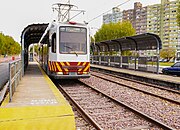Premetro (Buenos Aires)
| Premetro Buenos Aires | |||||||||||||||||||||||||||||||||||||||||||||||||||||||||||||||||||||||||||||||||||||||||||||
|---|---|---|---|---|---|---|---|---|---|---|---|---|---|---|---|---|---|---|---|---|---|---|---|---|---|---|---|---|---|---|---|---|---|---|---|---|---|---|---|---|---|---|---|---|---|---|---|---|---|---|---|---|---|---|---|---|---|---|---|---|---|---|---|---|---|---|---|---|---|---|---|---|---|---|---|---|---|---|---|---|---|---|---|---|---|---|---|---|---|---|---|---|---|
| Route length: | 7.4 km | ||||||||||||||||||||||||||||||||||||||||||||||||||||||||||||||||||||||||||||||||||||||||||||
| Gauge : | 1435 mm ( standard gauge ) | ||||||||||||||||||||||||||||||||||||||||||||||||||||||||||||||||||||||||||||||||||||||||||||
| Dual track : | available | ||||||||||||||||||||||||||||||||||||||||||||||||||||||||||||||||||||||||||||||||||||||||||||
|
|||||||||||||||||||||||||||||||||||||||||||||||||||||||||||||||||||||||||||||||||||||||||||||
The Premetro (line P or officially line E2) in Buenos Aires is a road or rail that the metro network of Buenos Aires Underground added. It connects the southern terminus of the E underground line, the Plaza de los Virreyes, with the southern district of Buenos Aires Villa Lugano and the General Savio block of flats. The journeys to Centro Civico count as drop journeys. The Premetro has separate tracks for 6.4 km, often on the median of streets. At 800 m, the tracks are centered on a carriageway. The 7.4 km long route opened in 1987 and is operated by the Metrovías . There are transition tickets for the underground and Prometro.
End of the branch line at the Centro Civico in the Villa Lugano district
history
The Premetro was opened in stages. The first section between the subway transfer point Int. Saguier and Ana María Janer opened on April 28, 1987. The line to General Savio was completed on August 25, the inauguration celebrated two days later.
From 1996 to 2006 the number of passengers was over 2.5 million a year. Then they fell to less than a tenth (228,000) by 2013. since then they have been slowly increasing again. In 2015 there were just over a million passengers.
The most important reason for the drop in the number of transports is considered to be the sharp increase in fares in Buenos Aires' local rail transport. In 2012, for example, the price of a subway ticket rose from 1.1 to 2.5 pesos. In the Spanish Wikipedia, an extremely high number of black journeys is suspected, as there are almost no ticket controls.



